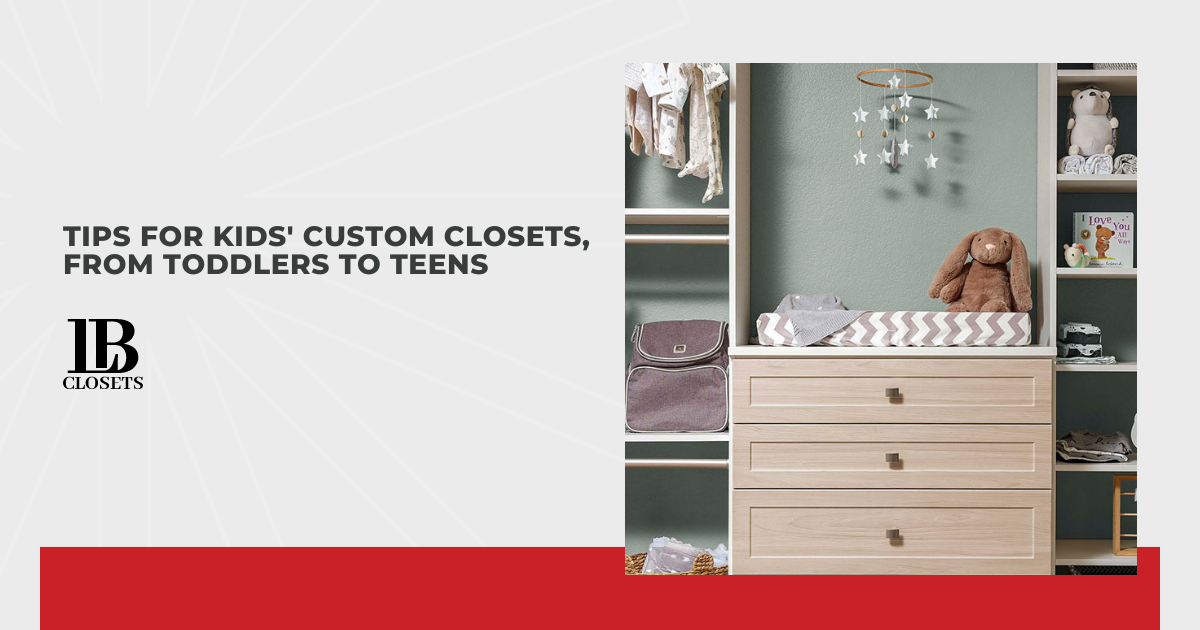Kids need closet space just as much as adults do, but setting up a kids’ custom closet can be challenging, especially because their needs will change as time goes on. A toddler doesn’t need the same things from their closet as a teenager, and they both will need different things than an adult would. Is there a way to create kids’ custom closets that can serve your children from the toddler to teen years?
- Plan Ahead with Adjustability
- Incorporate Baskets for Ease of Use
- Create Storage for Toys and Books
- Adapt with More Drawers and Cabinets
Learn how to plan closet space that will make sense for your child at any age.
Plan Ahead With Adjustability
If you’re planning to stay in your home long-term, your child will need to be able to use their closet through many different developmental stages and growth cycles. One thing you can be sure of is that their needs aren’t going to stay the same. That doesn’t mean that you’ll need to renovate their closet completely every couple of years, though. It just means that you’ll need to plan ahead and make sure that your child’s closets can grow with them instead of being outgrown.
You can do this with adjustable features. Items like hanging rods and shelves can be adjustable so that you can set them at low heights for younger children and raise them as your children grow. That way, they can always reach for their things and use their closet independently when they’re younger and they won’t have to stoop to continue to do so as they grow. You may need other features that can easily be moved or replaced as well, for example, cubbies that can be replaced with cabinets or dresser drawers later.

Incorporate Baskets for Ease of Use
Teaching children to be independent when it comes to putting clothes away and cleaning up their closets is a good idea. However, expecting them to perform just like an adult from a young age is a setup for failure. Your child isn’t likely to be able to fold and stack small things neatly and may actually forget to deal with things they can’t see, such as items in closed drawers. You have to start with things they can handle.
Open baskets for items like socks, underwear, pajamas, swimsuits, and other items that don’t necessarily have to be folded are a great idea for younger children. They may not be able to easily pair socks, fold them up, and arrange them in a drawer, but they can certainly toss them into a basket and then pull out a pair when needed. This also works for accessories like hair ribbons, barrettes, ponytail holders, and headbands. Don’t expect artful arrangements of these items from your elementary schooler; just give them a basket where they can be corralled neatly and found when needed.
Create Storage for Toys and Books
Unless you have a dedicated playroom, your child probably has toys and books that will need to be put away at the end of each day, and the closet is frequently used as a space for these kinds of non-clothing items. Clear plastic or solid-colored bins with labels are one solution. You can have your children store toys inside, and they can tell what’s there either because they can see through the clear plastic or check the label (you can use markings like shapes or specific colors for a particular type of toy if your child is too young to read the words on labels yet.)
Cubbies are a good idea too, especially for items that can be stacked, like books. They’re also useful for children who might like to display certain items or keep certain things handier than they would be in a bin. Your child may have a bin holding dolls or stuffed animals, but a special teddy bear that comes to bed with them every night or a doll they especially like to look at can have a place of privilege sitting in a cubby. This works not only for storage purposes but also for letting your child have some practice decorating their room as soon as they’re ready.

Adapt with More Drawers and Cabinets
As your child grows into a tween and then a teen, they’ll have fewer toys and probably more clothes and accessories, as this is a time in their life when they’ll be inclined to try out different styles and fashions. At this point, it can be useful to move many of the baskets, cubbies, and bins and replace them with cabinets and dressers. Your child is more capable of folding and putting away clothes neatly, so these types of closet organizers are more useful.
Drawers that they can close and cabinets that they can shut also let your teen have more privacy. This is the time of their life when they’re looking for that, and it’s important to facilitate a sense of autonomy and safety when it comes to having private spaces in their own room. According to VeryWell Family, learning to use privacy appropriately is an important part of growing more independent and responsible for teens. Their closet is as good a place as any to start facilitating their ability to have private space.
Conclusion
A custom closet can serve kids throughout their childhood if parents incorporate adjustability, set reasonable expectations, accommodate non-clothing items that end up stored in children’s closets, and remember to adapt as their child grows.

